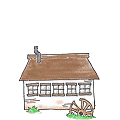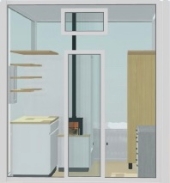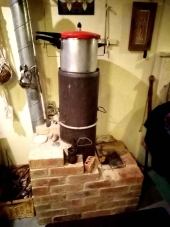
 5
5




![Filename: F521A723-2230-47C1-8BC1-C254E528CC50.jpeg
Description: [Thumbnail for F521A723-2230-47C1-8BC1-C254E528CC50.jpeg]](/t/172368/a/164434/F521A723-2230-47C1-8BC1-C254E528CC50.jpeg)




 5
5




For all your Montana Masonry Heater parts (also known as) Rocket Mass heater parts.
Visit me at
dragontechrmh.com Once you go brick you will never go back!
 1
1




 3
3




Neera Nagero wrote:
B) Any suggestions on ways I could add some thermal mass to retain heat? The stove only runs for about an hour because it's so small, so that would be helpful. It doesn't have to be pretty as long as it would be removable when cold season is over. I'd love to find something that could keep the temps decent until morning but I may be hoping for too much.
 1
1




Neera Nagero wrote:Hello everyone, thank you for being such a wonderful supportive community!
I wanted a rocket mass heater but it just won't be practical in my 8x14 foot house tiny house on wheels. I am opting for the cubic mini cub wood stove which is 11"W x 10"D x 12" H. I can at least use it as regular wood stove.
I'm still trying to find a creative solution to get benefits of rocket heater / mass but don't know the mechanics work. I have two questions:
A) Would it be possible to put a tiny portable RMH inside the wood stove (something as pictured which is only 8 inches high x 4 inches wide) if I wanted to use it as ro ]I would feel you need to understand just what a rocket stove is. And to put it into super simplistic terms, your burning a set amount of wood, as fast/hot as possible for 2-3 hours only per burn. When you start getting rocket stoves sized to below 4" flue requirements, they get harder to operate correctly. And it looks like your already there. You stated height of 8 and width of 4", but NO depth.. Doesn't really matter (as stated above reasons) , but this is nearly twiggs only in size.
B) Any suggestions on ways I could add some thermal mass to retain heat? The stove only runs for about an hour because it's so small, so that would be helpful. It doesn't have to be pretty as long as it would be removable when cold season is over. I'd love to find something that could keep the temps decent until morning but I may be hoping for too much.
Granite (scrap) pieces or soap stone would be your easiest to remove, type of MASS and could be Adjusted to be more or less. These are often 1 1/16" to 1 3/16" thick and any good rentable tile/brick saw, you could dimensional cut to your best shape. Hard to beat 4" x 4" Actually your really after the heaviest per volume object,
Sand is often tried, but almost always with poor results... Just to much air volume for your intended purpose.
Lastly, and again this is often done and even promoted, but if you try to make a steel stove work at the rockety temps, you will soon have galled or eroded steel.
Best of success, Scott
Thank you!
Maureen




I'm still trying to find a creative solution to get benefits of rocket heater / mass but don't know the mechanics work. I have two questions: [/quote wrote:
Instead of adding very heavy mass how about adding lite weight stuff - like 2" blue foam board underneath your trailer? And how good is the insulation inside? Would it be possible to add a layer of 3/4" foam board INSIDE your trailer? AND, don't forget the ceiling where most of the heat will be lost!
With more insulation your stove might just be enough to get you through a winter.
JayGee




Scott Weinberg wrote:
Neera Nagero wrote:Hello everyone, thank you for being such a wonderful supportive community!
I would feel you need to understand just what a rocket stove is. And to put it into super simplistic terms, your burning a set amount of wood, as fast/hot as possible for 2-3 hours only per burn. When you start getting rocket stoves sized to below 4" flue requirements, they get harder to operate correctly. And it looks like your already there. You stated height of 8 and width of 4", but NO depth.. Doesn't really matter (as stated above reasons) , but this is nearly twiggs only in size.
Granite (scrap) pieces or soap stone would be your easiest to remove, type of MASS and could be Adjusted to be more or less. These are often 1 1/16" to 1 3/16" thick and any good rentable tile/brick saw, you could dimensional cut to your best shape. Hard to beat 4" x 4" Actually your really after the heaviest per volume object,
Sand is often tried, but almost always with poor results... Just to much air volume for your intended purpose.
Lastly, and again this is often done and even promoted, but if you try to make a steel stove work at the rockety temps, you will soon have galled or eroded steel.
Best of success, Scott

 1
1




Nicole Alderman wrote:
You might like this thread: Affordable way to add mass to existing woodstove. There's a lot of ideas and examples in that thread, from using bricks to soapstone to containers of water and mroe!




Jesse Glessner wrote:
I'm still trying to find a creative solution to get benefits of rocket heater / mass but don't know the mechanics work. I have two questions: [/quote wrote:
Instead of adding very heavy mass how about adding lite weight stuff - like 2" blue foam board underneath your trailer? And how good is the insulation inside? Would it be possible to add a layer of 3/4" foam board INSIDE your trailer? AND, don't forget the ceiling where most of the heat will be lost!
With more insulation your stove might just be enough to get you through a winter.
Thank you, Jesse! Good point about insulation (and how it helps the cause of heat retention while also being lightweight). I will keep that in mind while doing my build. You also just gave me the idea of perhaps putting rigid foam inserts into my few windows at night to keep the heat in. It will be interesting to see how this all shakes out in the end, but I'll do my best to take what steps I can... and winter will then be the true test!
 2
2




 1
1




JayGee
 1
1




 1
1




Jesse Glessner wrote:
I'm still trying to find a creative solution to get benefits of rocket heater / mass but don't know the mechanics work. I have two questions: [/quote wrote:
Instead of adding very heavy mass how about adding lite weight stuff - like 2" blue foam board underneath your trailer? And how good is the insulation inside? Would it be possible to add a layer of 3/4" foam board INSIDE your trailer? AND, don't forget the ceiling where most of the heat will be lost!
With more insulation your stove might just be enough to get you through a winter.
Hi Jesse! Thanks again for this suggestion. I was logging onto permies for off grid advice and thought I'd share an update. Your feedback influenced me to go all out on insulation in my build. I believe this is an important place to invest given that I live in a cold climate. I've arranged for 5" spray foam in the trailer floor, will have vertical strapping on walls to decrease thermal bridging / increase insulation... and I'm working on getting someone to spray foam the roof where insulation is key. Way more practical than a masonry heater
 1
1




Lesa NeSmith wrote:I had a Cubic Mini Grizzly in an off grid vintage 20 ft trailer one winter... because of my extreme weather patterns, the 3 in stovepipe and the stoves love of compressed wood for burning NOT the free firewood I have available to me at my Off-grid Micro Homestead. I sold the stove the next summer. I am on a ridge/hill with high winds that also caused back drafts!
I would suggest a different size and style of stove (perhaps a Guide Gear or Winner Well or Russian Bear stove) If you will be okay with the maintenance of a 3 in stovepipe - realize that, depending on your installation and location maintenance could be cleaning it every week to 10 days. Are you okay with that.
I understand the size of the stove maybe important in your space. Please think it over well. Stoves and the stove pipe is expensive.
Also it's worth it to insulate or at least skirt any home on wheels.
I hope this is helpful and not discouraging. I loved how cute the Cubic Mini stove is. Although IMHO cute won't keep me warm no matter how hard I tried! They are best for mild winter's when simply taking a chill off.
Best of success with your stove choice.
You can Moosage me with questions.
 1
1




Marty Mac wrote:I have a 8.5 x 20 foot Tiny house 2x4 walls r 13 insulation for the most part but in small areas where fiberglas is more difficult to get even coverage I used 2 inch foam cut to fit as tight as I could during the framing phase. Then wrapped the entire house with half inch foil faced foam that was rated at r3. All plywood seams, windows, doors and electrical outlets are taped and sealed air tight. and Then the siding went on. I think the only way I could have done a better job would have been to have spray foam professionally done. I just couldn't justify the cost at the time. All this just to give you an idea of what I am trying to heat.
I have a hobbit stove https://salamanderstoves.com/product/the-hobbit-stove/ Love this stove! It works as good as it looks. Easy to lite easy to clean just one problem, burn time. I have found 6 inch is the best length to aim for when I cut fire wood. Some would say that is a problem, and I suppose if you need to buy firewood it would be. I live in a hard wood forrest and cut my own so no problem. The up side, a stubby little 6 inch log is really easy to split!
Just an example, mid teens outside. I can tell you that one load in my stove can take the tiny house from 50 to 75 degrees in the time it takes to burn itself out. About an hour to an hour and 15 minutes. My house will hold it above 60 degrees for about 2 hours. If I am home during the day that's a little inconvenient but not that big of deal. If I had to work 8 to 10 hours away from the house, freezing pipes would be a real possibility without an alternate heat source. I do have grid power and I use a very small 500 watt convection heater with a thermostat. https://www.eheat.com/envi-120v-plug-in-electric-panel-wall-heater-3rd-generation/ This little heater held the house at 50 degrees while outside temps were in the teens.
But to answer your question, I think Thomas's Idea of bricks with iron spanning from one wall to the other will help some with the temperature swings. The problem I have found Is if I try to heat the stone around my stove to a temperature that I can actually feel that warmth. My tiny house will be over 90 degrees inside.

|
Willie Smits understands 40 languages. This tiny ad knows only one:
The new purple deck of permaculture playing cards
https://www.kickstarter.com/projects/paulwheaton/garden-cards
|






